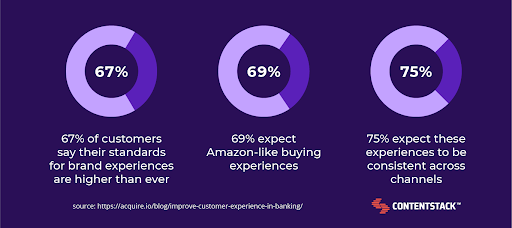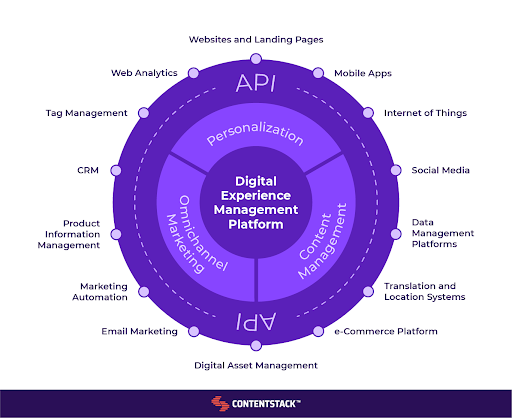You may have heard the term “digital experience management,” or “DXM.”
If you’re going to devote your budget and team to adopting DXM, you should know what it really means for businesses, why marketers need to care and how to set up a system for managing your digital experiences using new tech along with the tools you already have.

What is Digital Experience Management?
In the context of DXM, experiences include every interaction a consumer has with your business. These experiences might range from a repeat customer making a 15th purchase to a Facebook user clicking on an ad and landing on your mobile website for the first time.
The management part is pretty straightforward. With a DXM strategy, your goal is to manage each experience to ensure consumers and leads enjoy the seamless, personalized interactions they’ve come to expect.
Effective DXM involves input from a range of departments in your organization. The tools and techniques you bring together to manage digital experiences might collectively be called a digital experience platform (DXP).
Why Should Marketers Care about Digital Experience Management?
You might have heard that today the experience is the brand.
Catchy, but what does that mean?
It means the digital interactions customers and leads experience with your business are as important to them as your branding, products and prices — sometimes more important.

In fact, 70% of customers report that seamless experiences — think handoffs from one customer service agent to the next, ads that are hyper-focused on a customer’s on-site behavior, relevant marketing emails based on a specific purchase, etc. — are important when it comes to gaining their business.
So it’s no surprise that 72% of consumers expect businesses to personalize their experiences.
And if businesses can’t be bothered to do so? Well, remember: The most significant percentage of consumers — 76% — say it’s easy to keep looking until they find a brand that meets their digital experience expectations.In
When 51% of customers note most companies they interact with fall short in delivering on their experience expectations, it can be simple to set your company apart.
In fact, here’s how you can get started.
How to Build a Digital Experience Platform for Your Marketing Team
The ecosystem of marketing technology (MarTech) is huge — and growing by the year.
More than 8,000 MarTech tools are in use today. The capabilities of these tools are a double threat: They raise customer expectations and they overwhelm businesses trying to keep up with modern marketing demands.
So, let us simplify it for you. When it comes to building a digital experience platform, these are the core functions you want your DXP to help your marketing team execute:
- Personalized experiences
- Omnichannel marketing
- Overarching content management
No matter what your business does, your DXP needs to do those things to make it worth the time you’re going to spend building it.
But how will it do those things? With a variety of technology tools, which can include:
- Ecommerce management
- Customer relationship management
- Customer data management
- On- and offsite analytics
- Marketing funnel automation
- Translation and/or localization
- Digital asset management
- Advertising management
As you’re likely aware, there are options when it comes to specific tools in each of these categories. If you need help narrowing down options, this 4-Step Roadmap to Achieving Hyper-Personalization has plenty of recommendations for several of these categories.
In addition to the tools that make up your digital experience management workflow, the platform will enable them to work together and empower marketing teams to efficiently serve personalized, omnichannel content experiences.
Ready-made, dedicated digital experience platforms help organizations align their strategies, teams and technologies. But if you’re focused on content-driven experiences, the right content management system can provide the same benefits as a DXP.
A headless content management system (CMS) can be differentiated from a standard CMS by the way it delivers content via application programming interface (API) technology — which untethers the back end (the “body”), where content is created and stored, from the front end (the “head”), where content is formatted and delivered.
This is the ideal set up for a digital experience platform, as the APIs can pull data from any sources (like customer relationship management, customer data or localization platforms) and leverage logic to optimize content for the right individual and the right channel at the right time.
This modular architecture not only enables developers, designers and content folks to work alongside yet independently of each other, but APIs also empower easy integration between the ecommerce platforms, analytics tools, CRMs and other technology you’ve chosen for your DXM program. This flexibility empowers scalable and future-ready digital experiences across your websites, applications, social media channels, email campaigns and more.

Start Building Your Digital Experience Management Program Today
As you can tell, choosing your DXM tools and the platform that “glues” them together is an important and somewhat delicate process. But it’s one you need to begin if you plan to get anywhere with a digital experience that delivers when it comes to demands from customers and leads.
To learn why headless CMS is the preferred solution for an integrated digital experience strategy, enjoy this complimentary copy of Gartner’s report: Elevate Your Horizontal Portal to a Digital Experience Platform.
Once you’ve understood the value of headless architecture, check out this headless CMS buyer’s guide, which will help you determine whether a headless CMS is right for your organization, how to choose the right one and features to look for.
The last step before you’re ready to make big decisions about a CMS upon which to build your DXM program is to take a look at this guide to make sure you’re familiar with the ins and outs of API technology and that you’re prepared to choose a solution that is API-first.
Related Articles
Here are some CMS articles we think you'll find useful.
How Headless CMS Delivers Content and Digital Experiences to Customers
Learn about headless CMS industry trends, real-world use cases, and CMS implementation best practices, and how enterprises can support a multitude of digital experiences with an API-first CMS architecture.
Read more
Headless CMS Survey Results: Taking a New and Improved Approach to Content Delivery
Delivering seamless digital experiences across the touchpoints of the customer journey is tough. This Gartner report explains why “application leaders in charge of customer experience should implement a composable user experience aligned with specific personas.”
Read more
Content and the Omnichannel Digital Experience
Here's everything you need to know about new consumer expectations and how to scale to meet them without sacrificing the quality and consistency that your audience has come to trust.
Read more
